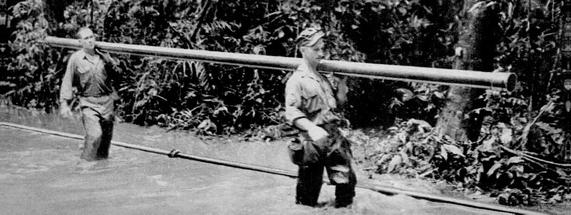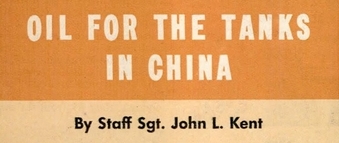|
|
IT NOW may be told that General Patton's great 80-day dash across France was delayed at one point for a week because of lack of gasoline for his armored vehicles - gasoline of which there was plenty in the depots in the United States and England, and even at the captured French ports, but which could not be brought up to the fighting troops in time. Transportation of gasoline and Diesel oil is one of the greatest problems of this war of supply.
Gasoline and Diesel oil are needed to power the multitude of vehicles upon which modern mobile war depends. Gas is consumed in unheard-of quantities. In the comparatively small, although costly, invasion of Iwo Jima, the United States forces were supplied in the first two weeks with enough oil to make a 238-mile train of tank cars of 10,000 gallons each, enough gasoline to operate 30,730 automobiles for a year and enough lubricating oil for one complete change for 466,000 cars.
In China and Burma our Army is faced with supplying oil and gasoline in astronomical quantities for the coming showdown fight on the Asiatic continent. Truck supply could never take care of the needs even if roads were available - and they aren't! To move the gasoline from our bases in India over the only existing road - the newly built Ledo-Burma connection - more gas would be consumed by the truck than it would deliver.
To get gas to our troops in advance bases, a number of B-24 Liberator bombers were converted into gas cargo ships known as C-109's to fly a shuttle route from India to Myitkyina, Burma. From there the gas and oil is delivered by truck to forward areas, or used to fuel the planes at the Myitkyina air base.
Superfortresses, too, have been converted into fuel carriers. Without their turrets or waist windows, they fly from the supply depots in India to camouflaged fields in Burma and China.
Transportation of gasoline and oil by this method is not only extremely expensive, but the amount of gasoline and oil so delivered is the proverbial "drop in a bucket." It is a makeshift method born of the necessity of getting any amount, no matter how small, to the Chinese infantry and our Air Forces in southern China. The Army finally decided that the problem could be solved only by pipe line.
The Army had built small pipe lines in France which helped to power the invasion forces driving into Germany but no pipe line thus far built compares with the giant link now nearing completion in China-Burma-India Theater. No one knows exactly how long the pipe line will be ultimately. It may cover 2,000 miles and stretch from Calcutta, India north and east to Kunming.
Material for the part of the line being built in the Assam area began to arrive at the Allied base of Ledo in early fall of 1943. By early December, 1944, one third of the line was in operation, and by January, 1945, motor gas, aviation gas, and Diesel fuel were being dispensed at all required points between Ledo and the advance base at Myitkyina.
 Above, "switch yard" for pipe line from India was installed by U.S. Army Engineers.
Right, bolts on the completed joint are tightened after rubber gasket ring has been slipped over end of pipe.
Below, GI takes "pulse" of line at pressure gauge.
Above, "switch yard" for pipe line from India was installed by U.S. Army Engineers.
Right, bolts on the completed joint are tightened after rubber gasket ring has been slipped over end of pipe.
Below, GI takes "pulse" of line at pressure gauge.

|


|
In southeast Asia heat, tropical rains, leeches, malarial mosquitoes and other insects made life for the engineers a hell on earth. Malaria control units had to be attached to the construction battalions. Drainage ditches were dug and slow-moving streams in the vicinity of camps were sprayed with oil to kill the mosquito larvae.
At one time 7,000 coolies were helping the United States forces in building the line. Later there was aid from the Indian Pioneer Corps. The 10th U.S. Army Air Force rendered valuable service by dropping rations, medical necessities and mail to detachments working in otherwise inaccessible places.

|
Official visitors have brought back praise for this Army engineering feat. Congressman Mansfield of Montana told the House of Representatives about the "epic job" of the American engineers in the Burma jungles. He spoke of sections where the pipe was trucked as far as it would go and then dragged by bulldozers. Rafts and pontoons with outboard motors were called upon when pipe had to cross the thousand swamps and streams. Over the numerous ravines, the pipe had to be hung on cables.
Pipe lines are used because they can send liquids rapidly over terrain too rugged or distances too long for other means of transportation and relieve congestion where road capacity is limited. All these conditions are present in the China-Burma-India Theater.
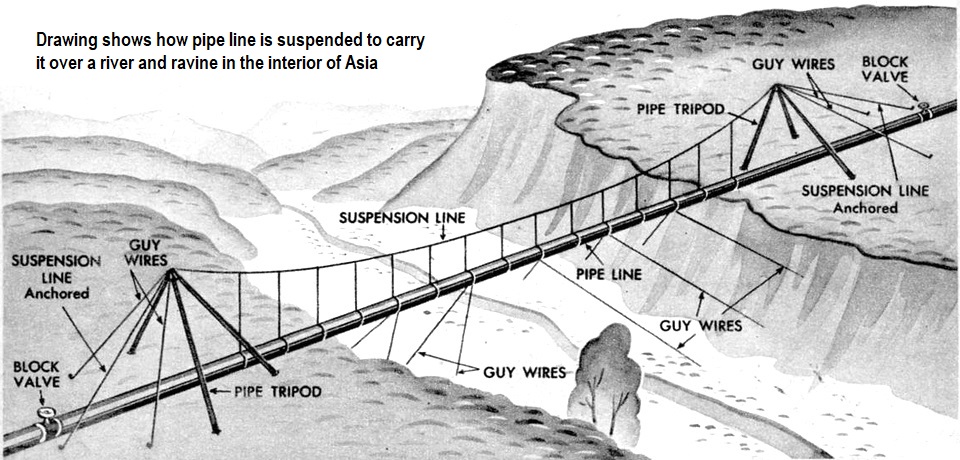
|
Military pipe lines are usually laid out along a course which provides maximum concealment from enemy observation. Small brush may be an inconvenience in laying the line but it is left undisturbed because it provides camouflage. Light-weight pipe of the spiral or longitudinal weld types is commonly used. All pipe is grooved on each end to accommodate the Victaulic type of coupling and is supplied in standard lengths of 20 feet.
This Victaulic coupling has made possible the speedy construction of military pipe lines even on unstable ground. The coupling allows for angular deflection and for contraction and expansion of the line. The ease with which it may be connected and disconnected has made the coupling the standard jointing device for all our pipe lines. It requires only one tool, a wrench.
The coupling is composed of a malleable iron housing in two parts held together by two bolts, which mechanically engage the adjacent grooved pipe ends in a positive lock. A single continuous hollow-molded sealing gasket is so installed that internal pressure or vacuum serves only to increase the tightness of the seal. Bombs may drop and shells explode almost on top of the pipe, the concussion lifting the sections high into the air, but the couplings hold. Ordinarily pipe is distributed from trucks if road conditions permit. In the jungle or other rugged terrain, such as in Burma, pipe was carried by hand for great distances.

|
To force oil through the pipe, pumping stations are installed along the line. Earlier Army installations used the reciprocating pumps employed on commercial pipe lines, but they proved heavy and cumbersome in the jungle and mountain country, so the Army started using centrifugal pumps. A two-stage centrifugal unit now being used is equipped with sand traps to hold back any impurities and is designed for a working pressure of 700 pounds per square inch. A built-in increaser gear and complete manifolding allow the two stages of the pump to be operated either in series or parallel. When operating in series, the pump has a capacity of 200 barrels per hour at 200 pounds pressure.
On downhill stretches of the lines, diaphragm-actuated regulators are used to reduce pressure in the line due to gravity. They are in a sense safety valves.
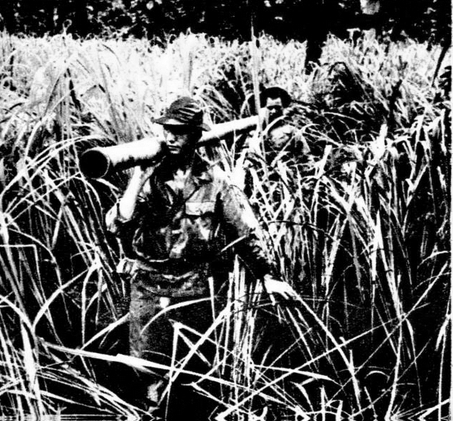
|

|
Normally a maintenance and repair crew is based at each pumping station. Security patrols are maintained along the line at all times to prevent sabotage, to search for small leaks and to report other mishaps to the line. These patrols are equipped with field telephones for communication with the pump station, which can quickly close down a line if necessary and prevent loss of oil or gasoline.
The worst part of the Ledo pipe line will come when it is taken over the high mountains into China. But Army engineers are determined that the vital fluid shall get to China to enable the Chinese and their Allies to defeat the foe as quickly as possible.

|
FOR PRIVATE NON-COMMERCIAL EDUCATIONAL USE ONLY
TOP OF PAGE PRINT THIS PAGE ABOUT THIS PAGE SEND COMMENTS
SEE THE ORIGINAL ARTICLE REMEMBERING THE FORGOTTEN THEATER OF WORLD WAR II
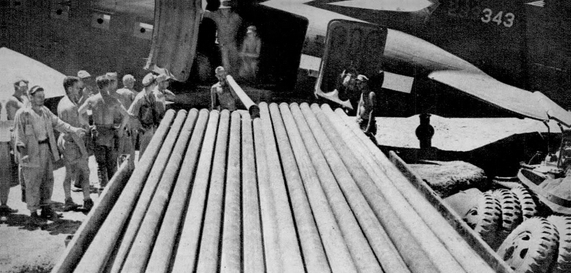 U.S. soldiers in Burma load 4-in. pipe on trucks.
Below, toting pipe through jungle.
U.S. soldiers in Burma load 4-in. pipe on trucks.
Below, toting pipe through jungle.
